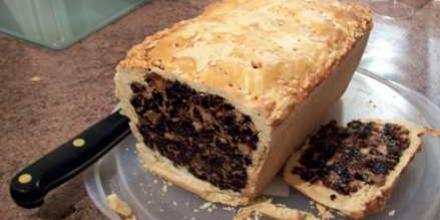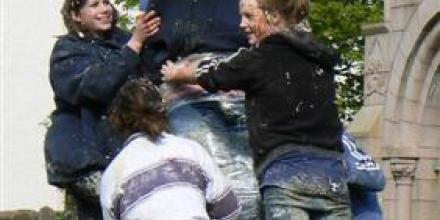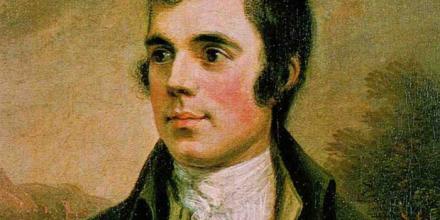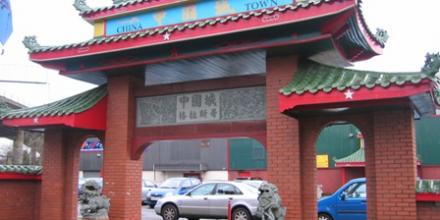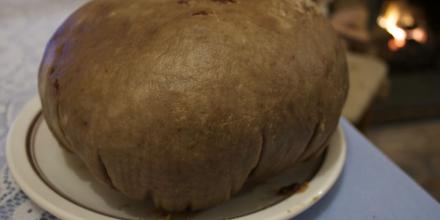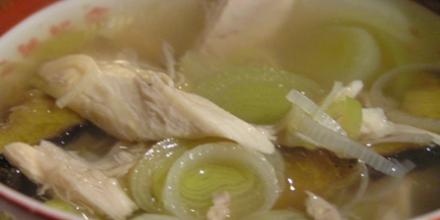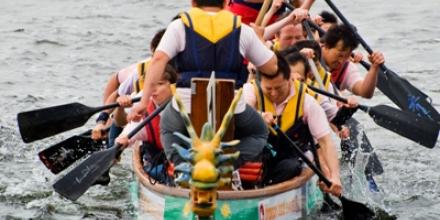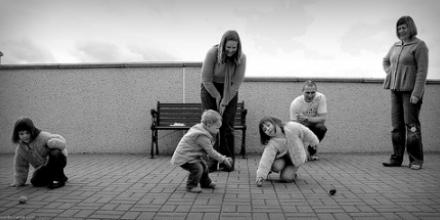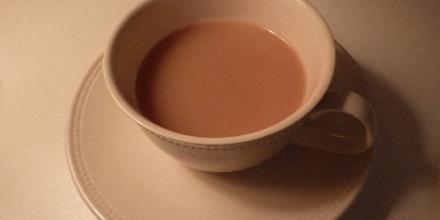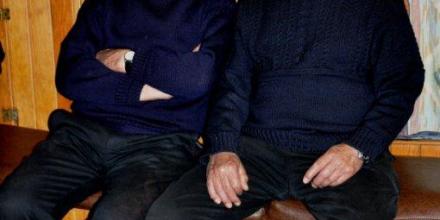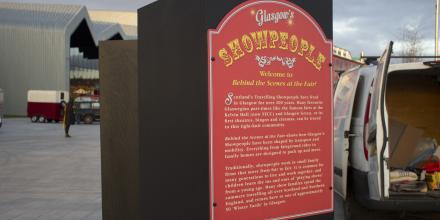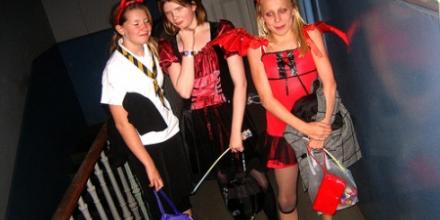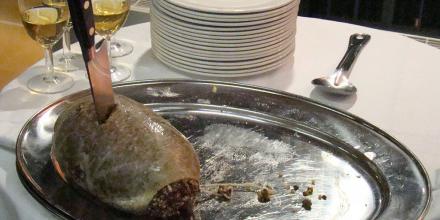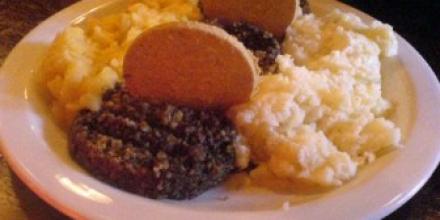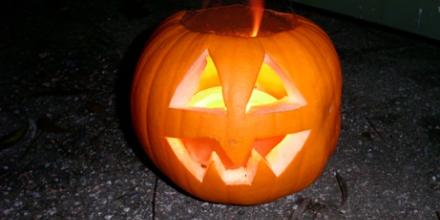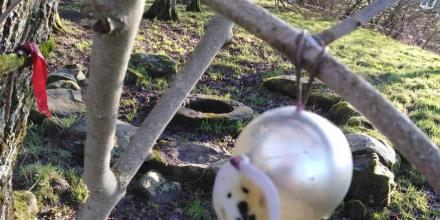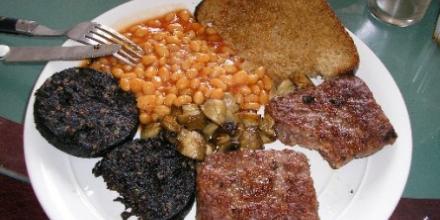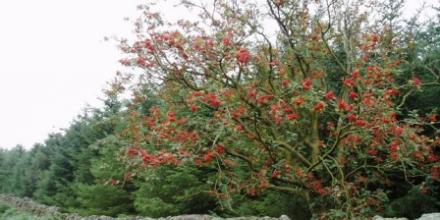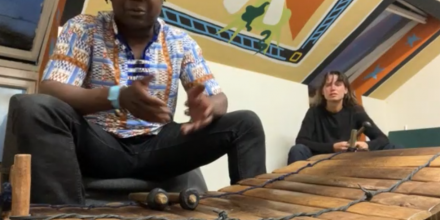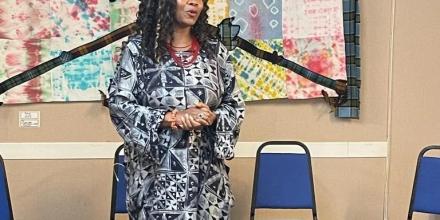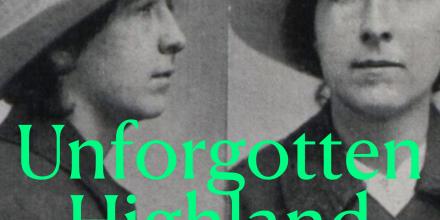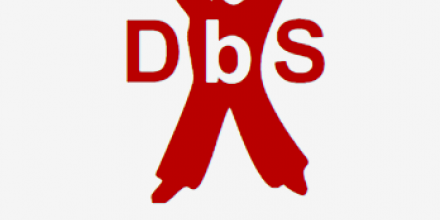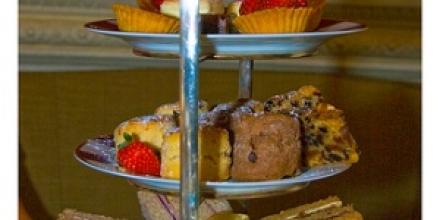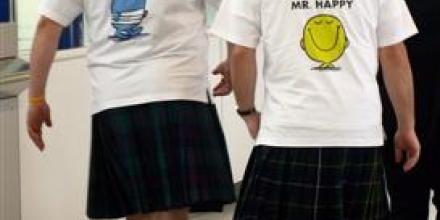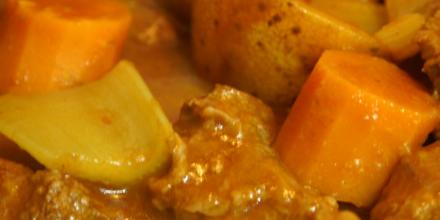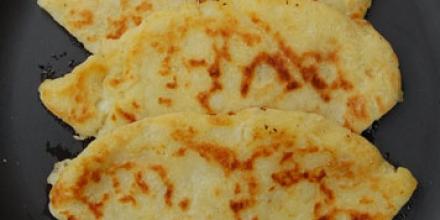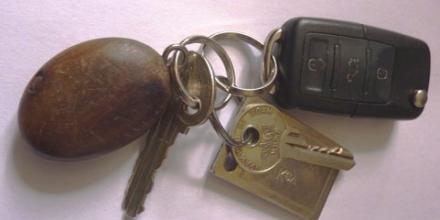-
-
Blackening
This is a ritual usually perpetrated upon a soon to be married man before his wedding, but in some places (see above example from Kirkwall in Orkney) carried out by and on females! Workmates and friends organise and carry these out. More widely this involves the soon-to-be-married man being caught, stripped of much of his clothing (at least to the waist) and tied up. He is then 'blackened' (traditionally with tar, soot or sometimes treacle) then covered also with flour and/or (traditionally) feathers. He is... Read More
-
Bridal traditions - Scottish
Sixpence in the Bride's Shoe A sixpence (silver coin) placed in a bride's shoe is believed to bring her good luck. Possibly related to the last line (less well known than the rest) of:
Something old, something new Something borrowed, something blue And a silver sixpence in her shoe
Each of the above is believed to bring good luck and a happy marriage. "Something old" for continuity with the past and with her family; . "Something new" to bring hope for... Read More -
Burns Supper
A Burns supper is a celebration of the life and work of the poet Robert Burns. The suppers are normally held on or near the poet's birthday, 25 January, sometimes also known as Robert Burns Day or Burns Night (Burns Nicht), although they may in principle be held at any time of the year. Burns Suppers are held across the world. Burns suppers are most common in Scotland and Northern Ireland, but occur across the globe wherever there are Burns Clubs, Scottish Societies or expatriate Scots. Burns suppers may... Read More
-
Chinese New Year
The Chinese community in Scotland, originating from both Mainland China and Hong Kong, numbers just over 10,000 people with the most significant population in Glasgow. Charing Cross and Garnethill are two areas of Glasgow that have become Scotland’s Chinatown. Like other Chinese communities worldwide, the Scottish Chinese have their own New Year celebrations, which have now become a significant feature of the Scottish winter cultural calendar, particularly in Glasgow and Edinburgh. Organisations such as t... Read More
-
Clootie / Cloutie Dumplin
This is a fruit based dumpling cooked in a cloot or clout (cloth). Everyone has their own recipe. See one at http://www.scottishrecipes.co.uk/clootiedumpling.htm and see film of one being made at http://scotland.stv.tv/food-drink/recipes/128262-clootie-dumpling-custard/... Read More
-
Cock a Leekie Soup
Cock a Leekie Soup is a soup, traditionally served in the winter, made with leeks and chicken stock. It is frequently served as a starter at Scottish events such as Burns Night, St Andrews Night and at Hogmanay. As www.scottishrecipes.co.uk explains, the soup dates back to the 16th century when a fowl would be boiled with vegetables such as leeks to provide a filling broth and this is why Cock a Leekie soup is so named. A traditional Scottish Cock a Leekie soup recipe includes prunes though some cooks will ... Read More
-
Cran
'In Great Britain, at least as early as the 18th century – 20th century, a unit of capacity for fresh herring before cleaning, since 1852 the quantity needed to fill 37½ imperial gallons (about 6.03 cubic feet, or 170.5 liters). From the Gaelic crann, a measure for herring. Sometimes spelled crane. Under the Herring Industry Board's rules, and Weights and Measures Regulations, any herring not sold by the cran must be sold by weight. A cran typically contains about 1200 fish, but can vary from 700 to 2500... Read More
-
Cranachan
Cranachan is a traditional Scottish dessert. It is usually made from a mixture of whipped cream, whisky, honey, and fresh raspberries topped with toasted oatmeal. It is sometimes called Atholl Brose (which is more properly a drink using similar ingredients) and Cream Crowdie. A traditional way to serve the dessert is to bring dishes of each ingredient to the table, so that each person can assemble their dessert to taste. Tall dessert glasses are also of typical presentation. It was originally a summer dish... Read More
-
Cullen Skink
Cullen is a small town in the North east of Scotland, the traditinal home of the soup Cullen Skink. The soup is traditionally made with Finnan haddock, potatoes and onions. Finnan haddock is often called Finnan haddie. The word skink means soup or stew. ... Read More
-
Dookin' for Apples
Dookin' for apples normally takes place in a large bucket of water. Around a dozen apples are allowed to float around the surface and the player tries to pull out an apple using only their mouth. A clever player may try and align their mouth with an apple stalk to remove it from the water otherwise the player has to try and take a bite of the apple whilst removing it from the bucket. If a player takes too long they may find their own head being dooked into the bucket by those waiting for their own turn and ... Read More
-
Dragon Boat Racing
Four boats raced at part of series of events, organised as part of China Now in Scotland, which raised funds to support the Tayside Chinese Community Centre and Dundee Chinese school. There are many Dragon boat races that take place throughout Scotland. On May 30th 2010, Consul General Tan Xiutian attended the Dragon Boat Race at the invitation of Dumfries and Galloway's Provost, Jack Groom. The event was organised by the city Council and Rotary Club with strong support from the local Chinese Community. (so... Read More
-
Dry-Stane Dyking
Dry-stane dyking is the traditional art of constructing walls without mortar. ... Read More
-
Egg rolling at Easter
Method: using boiled eggs, wait until these have cooled down, and then paint. The decorated eggs are then taken to a gentle hill (or other appropriate place) and "rolled". The rolling of the egg symbolises the rolling away of the stone from Jesus' tomb at Easter. Although as a kid and from years of experience with my own children the symbolism is lost as they munch though a mound of chocolate. Our local hill is always littered with eggs and shells and serves as a feast for the local wildlife. Chocolate ... Read More
-
Elastics
I was speaking to my niece recently, age 8, and she mentioned that she plays elastics with her friends and it brought back a lot of memories. It was one of my favourite games when I was at primary school. You play by tying elastic bands together to make a large loop of elastic. It is a game for three people, although I used to practice a lot in the house using chair legs when there were no other friends around. Two players stand inside the loop so they are stretching it relatively taught around their ankles... Read More
-
Finnechty Cup
"Finnechty cup" is an expression that comes from the area on the Moray Coast in the North East of Scotland surrounding the village of Findochty, "Finnechty" being the local pronounciation of Findochty. Apparently, it was the perception of the inhabitants of the neighbouring villages that the folk in Findochty were rather ungenerous when pouring out a cup of tea! Hence the saying came into being and any cup of tea anywhere which was not deemed to be full enough was referred to as a fine "Finnechty cup". I... Read More
-
First-footing
A First foot (or 'fit') is the first person to enter your house or cross your threshhold after midnight on 31st December or Hogmanay. Traditionally a dark-haired man (or even a coalman) was thought to bring good luck, but anyone can be your first foot and you can be anyone else's. Again traditionally, when first-footing, you should take a lump of coal (fuel), whisky and Black Bun (sustenance) to the household. ... Read More
-
Fish supper
The 'Fish Supper' consists of fish (commonly haddock in Scotland) deep fried in batter with chips purchased from a 'Chip shop'. It is traditionally served wrapped first in brown paper, then in newspaper in order that the food should retain its heat on the customer's journey home. This is more than a foodstuff in Scotland - it is truly a tradition. The traditional question from the Chip Shop proprietor to the customer on serving the delicacy: 'Anyhin oan it?' can be met with the reply,'Sauce an salt' i... Read More
-
Fishermen's Ganseys
Fishermen have been wearing ganseys (Guernseys) since about the start of the 17th Century - the design is said to have been developed in the Isle of Guernsey, just the same way that the term jersey originated from the neighbouring Channel Island of Jersey. Ganseys were knitted in un-oiled, soft, round, dark-blue 4 ply wool on four size 14 needles to make a firm, close fabric that was almost wind and waterproof. They were one-piece garments. A split had to be made at the underarm, the back and the front t... Read More
-
Fishing Superstitions
Perhaps because of the hazards of their occupation or their mutual reliance, fishing communities developed their own unique customs and folklore. They were tight-knit and conservative and their names, food and mode of life were different from the surrounding population. Even between different fishing villages there was often rivalry and it was rare for them to marry outwith their own community. Because of the dangerous nature of their work, they were unusually superstitious. Thus there were words conside... Read More
-
Glasgow's Travelling Showpeople Community
" Travelling Showpeople opened Glasgow's first cinemas, operated the rides and stalls at the annual Kelvin Hall Winter Fair and Glasgow Green. As the winter base for over 80% of Scottish show families, Glasgow has the largest concentration of Showpeople in Europe. Yet the unique traditions and histories of this tight-knit community are still unknown to most of the Scottish public." The quote above was taken from a publication that was produced as part of the Fair Glasgow project. This project was initia... Read More
-
Guising
Guising is the term given to the Scottish/Irish Halloween tradition of children going from house to house in the neighborhood in disguise (hence the term) and collecting food treats from the neighbors. The Scottish tradition of 'guising' can be traced back to Samhuinn where people would use masks and decorations to disguise themselves and scare away evil spirits. Also see Hallow'een traditions ... Read More
-
Haggis
A traditional food of Scotland eaten across the country made from meat offal, herbs and spices contained within a natural or artificial skin that is ball-shaped; can also be made as a vegetarian variety. Haggis features in the ICH of the traditional New Year ceremonies and Burns Night. Haggis is exclusively a Scottish traditional food not associated with any other country.... Read More
-
Haggis Pakora
Pakora is a foodstuff of South Asian origin [see http://en.wikipedia.org/wiki/Pakora] Made by binding several ingredients together (onion, potato and other vegetables), coating them in batter then deep-frying them, it is easy to understand why pakora has become popular in Scotland. In addition to chicken pakora, the fusion of Asian and Scots’ cultures has seen the introduction of a haggis variety. ... Read More
-
Haggis, Neeps and Tatties
Haggis is a tradtional Scottish dish containing sheep's offal (heart, liver and lungs), minced with onion, oatmeal, suet, spices, and salt, mixed with stock, and traditionally simmered in the animal's stomach for approximately three hours (although nowadays haggis tends to be simmered in a casing rather than the stomach). It is often considered to be the national dish of Scotland, and is memorialised in Robert Burns' poem Address to a Haggis. Originally a modest dish ensuring no part of the sheep goes to... Read More
-
Hallow'een
allowe'en (Halloween ), celebrated on October 31 derives from the Celtic festival Samhuinn. Children go around peoples' houses (traditionally in costumes or fancy dress), asking for sweets or money although some still (voluntarily or otherwise) perform a song, dance or tell a joke in order to deserve the householder's contribution. Money used to be saved towards buying fireworks for another celebration on 5th November, Guy Fawkes Night. American influence and marketing in recent years has seen this incre... Read More
-
-
Hen Nights
Females about to be married are sometimes dressed up by their female work colleagues in a Bridal veil, balloons, flowers, streamers and "L" plates, and traditionally made to carry a chamber pot full of salt (sometimes with little dolls and other tokens stuck in) paraded through the streets to invite kisses from male passers-by (traditionally for a donation of money into the ‘potty’). This is still done, but has more commonly turned into a night-out for the prospective bride, her female friends and relat... Read More
-
Hogmanay
Hogmanay is the Scots name for New Year's eve. The tradition of seeing out the old year and welcoming in the new has, in cities such as Glasgow and Edinburgh, been adopted and transformed in recent decades to the point that 'Hogmanay' is now often associated with these huge public type of 'events' with firework displays. However many older non-commercial public events take place around Scotland e.g. the Stonehaven Fireball Festival or Comrie Flambeaux. Prior to the recent 'Edinburgh's Hogmany' festiva... Read More
-
Knitting Groups
Knitting groups have seen something of a revival in the last few years. They have been around for a long time, previously being known as "knitting bees" and would often have met in the home of one of the group members. These days knitting groups meet in all kinds of venues from museums to bars to cafes to people's houses. The purpose of the group is for members to learn knitting techniques from other members, to show patterns, to show new yarn and items in progress, adn of course to socialise. Knitters come... Read More
-
Living traditions surrounding Holy Wells, Historic Springs and Sacred Waters in Scotland
Holy or sacred wells, historic springs and related 'watery sites' are places in the landscape where 'knowledge and practices concerning nature and the universe' are enacted. These sites continue to be visited in Scotland for a variety of reasons; sometimes waters are perceived to have healing power or health-bestowing properties; sometimes the places themselves are thought to be efficacious because of their natural beauty, historical or spiritual significance. Holy wells are also entwined in other tradition... Read More
-
Lorne Sausage
Lorne sausage is a traditional cooked sliced sausage, which is enjoyed across Scotland. The origins of the name appear unclear, with there being some suggestion it is a reference to Scottish comedian Tommy Lorne. The sausage meat itself- which may be pork, beef, or a mixture of the two - is set into a square and sliced into pieces. It is usually served as part of a Scottish breakfast!... Read More
-
Mehndi (Hindi: मेहँदी, Urdu: مہندی)
‘Mehndi (Hindi: मेहँदी, Urdu: مہندی) is the application of henna as a temporary form of skin decoration in India and Pakistan’[see source below]and by women from Indian, Pakistani and Bangladeshi communities living in Scotland. Traditionally used for brides, it is still applied for weddings and also for other special occasions (mainly on the palms of the hands but also to the feet). It is a temporary decoration which sits on the surface of the skin, not a tattoo. After application by... Read More
-
New Year Calendar Tradition
In my home at New Year I never turn a calendar to show January until after midnight. I was taught from my Glasgow grandparents that it was bad luck to show the face of the calendar before the new year. Our tradition was to take down the old calendar on New Year's Eve and replace it with a new calendar, but to show the back blank page. When it was past midnight as a child I was allowed to turn all the calendars in the house around. I still carry this practise on today. In addition my family always thought it... Read More
-
Police Pipe bands
The tradition of Police Pipe bands extends beyond Scotland and across the world (particularly North America). As well as being called upon to play in public marches, processions and festivals (see Northern Constabulary photograph above), bands compete in Pipe Band Championships. They range in age from some relatively recently formed to those such as Lothian and Borders Police Pipe Band which goes back to1882... Read More
-
Rowan Trees
The tradition of planting a Rowan tree in a garden is still followed by some. The Rowan was believed to afford the house and its inhabitants protection from witches. Consequently, it is considered very bad luck to cut down a Rowan tree! The manifold uses of the rowan tree included it being grown for suitable timber for tool handles. It was known for its strength and density, which is advantageous when it comes to making handles for spades, cas-chrom, spinning wheels and walking sticks. Hugh Cheape descri... Read More
-
Scotch Collops
Scotch Collops are a traditional Scottish dish; the term 'collops' means 'thin slices of meat', and is derived from the French 'escalope'. The dish can be created using either thin slices or minced meat of either beef, lamb or venison. To prepare the dish, the meat slices are combined with onion, salt, pepper, and suet, then stewed, baked or roasted with optional flavourings according to the meat used. It is traditionally served garnished with thin toast and mashed potato.... Read More
-
Scotland's Year of Stories Project: One Life, Two Cultures
On the evening of Saturday 24 September African and Caribbean Elders in Scotland (ACES) hosted an online event offering a sneak peek at stories collected as part of their oral history project, One Life, Two Cultures. Twenty-five people attended the session. Nine different speakers shared their stories of life in Scotland and what it was like to move to the country from Ghana, Mauritius, Sierra Leone, Jamaica, the Gambia, Uganda, and Nigeria. Participants joined in from all over Scotland, including Glasgow, ... Read More
-
Scotland's Year of Stories Project: Seen & Heard - Stories of Scottish sport to inspire
As part of Year of Stories 2022, LEAP Sports teamed up with Pride of the Terraces to host a podcast called Seen & Heard. This podcast shines a spotlight on different aspects of sporting life in Scotland. Seen & Heard is created in association with Pride of the Terraces, Scottish Women in Sport and Scottish Disability Sport, and covered diverse topics such as Football and Homophobia, LGBTQIA+ sports journalism and the visibility of disability sports. You can listen to all the podcasts here: https://lea... Read More
-
Scotland's Year of Stories Project: Standing Tall Stories
Standing Tall Stories was a project working with separated young people seeking asylum in Scotland. The young people are supported by Scottish Guardianship Service, which provides tailored support for unaccompanied children in Scotland. In celebration of Refugee Festival Scotland on Saturday 18th of June Standing Tall Stories hosted an afternoon of arts, music, and food at Scottish Youth Theatre to celebrate the launch of this project and the work we have made so far. This event was catered by Afro-Fusion C... Read More
-
Scotland's Year of Stories Project: The Journey: Personal testimonies of Africans living and working in Scotland
“The Journey: Personal Testimonies of Africans living and working in Scotland" consisted of interviews conducted with members of the Scots-African community by Dr Sue Morrison; there was also music by Glasgow Small Pipers and food provided by Olivia Ndoti and other members of Women Integration Network (WIN) who prepared varied delicious array of International food & beverages. Olivia made a speech about importance of Black History Month, and Sean Reid facilitated "Integration through Proverbs", an explora... Read More
-
Scotland's Year of Stories Project: Unforgotten Highland Women
A jewel thief, a witch, a doctor and an inspirational teacher are just some of the stories of incredible Highland women revealed from museum archives. Unforgotten Highland Women is a short podcast series, recorded at live events across the Highlands of Scotland, about remarkable local women. Pauline Moore - podcaster and freelance producer - with support from the team at XpoNorth was commissioned by Museums and Heritage Highland to host these events, interviewing the keepers of the tales, sharing the storie... Read More
-
Scotland's Year of Stories Project: We all have a story to tell
On the 26th of October a series of BSL stories - at turns inspiring, funny, and poignant - were told by Deafblind Scotland members at the Storytelling Centre in Edinburgh. You can watch them all here: https://dbscotland.org.uk/year-of-stories-2022/ This event was supported by the Year of Stories 2022 Community Stories Fund. This fund was delivered in partnership between VisitScotland and Museums Galleries Scotland with support from National Lottery Heritage Fund thanks to National Lottery players. ... Read More
-
Scottish High Tea
The illustration provided is of a classic AFTERNOON TEA. A Scottish HIGH TEA would be something like poached eggs, fishcakes, or Welsh Rarebit, followed by scones, pancakes, fancy cakes if you were being a bit "society" and pot after pot of tea. It would not include sandwiches - the protein would have been provided by the hot something, whatever it was, and the starch by the scones and pancakes. ... Read More
-
Scottish High Tea
Normally served between 3-7pm, which is available in some hotels in Scotland. The meal offered varies from location to location. Usually it consists of toast/bread/rolls served with each course, soup or similar starter, main meal (fish or steak pie is common), a choice of puddings and then a huge plate of biscuits, cakes and fancies served on a cake stand. Tea is served throughout the meal. ... Read More
-
Scottish Wedding
The Scottish Wedding Reception Most Scottish weddings take place in mid to late afternoon and are then followed by a formal reception or party with a wedding meal. At the wedding meal toasts are made to the bride (by the Groom) and to the bridesmaids (by the 'Best Man' - the Groom's best friend and assistant). Speeches are usually made by the Bride's father and, occasionally nowadays, by the bride. Later in the evening the wedding dance begins, led by the bride and groom who are then joined in the 'first... Read More
-
Shrove Tuesday (Pancake Day)
This tradition has historically been used as a way to prepare for Lent in Scotland by clearing away the cupboard of all the sweets. It has evolved into what is now known as Pancake Day. During the day individuals will make pancakes and add sweet toppings whether it is for breakfast, lunch, dinner, or a late night snack. This tradition has been happening for centuries in Scotland and has recently been adopted even by those who may not be celebrating Lent. ... Read More
-
-
St Ayles Skiff
The 'St Ayles Skiffs' is a design commissioned by the Museum from renowned boat designer Ian Oughtred and are made from a plywood kit. It was inspired by the traditional Fair Isle Skiff. These reasonably priced kits can be purchased from Jordan Boats, partners in the project, with the Museum earning a royalty from each kit sold. Each skiff requires a team of four rowers and one coxswain to complete a full crew with each rower taking one oar. The 'Chris o' Kanaird' was the prototype boat built by Jordan B... Read More
-
Stag Nights
These have generally deteriorated into simply a night-out to mark the husband-to-be's 'last night of freedom' as a single man. Those taking part are the prospective groom, his male friends and male relations. It can still often involve dressing up (often of everyone concerned - see understated T-shirt approach in photograph above) when traditionally only the groom was humiliated on the night through Blackening. Stag nights can now stretch to entire weekends away or short trips abroad.... Read More
-
Stovies
Stovies is a traditional potato-based Scottish dish, although the precise ingredients vary widely. In addition to potatoes, the dish will usually contain onions and often leftover roast beef, mince or other meat. The potatoes are cooked by stewing with fat; stove also having the meaning of stew or to stew in Scots. Lard, beef dripping or butter may be used.... Read More
-
Tablet
Tablet is a hard, sugary slab of confectionary, with a brittle, grainy texture. It is usually made from sugar, condensed milk, and butter. It is often flavoured with vanilla, and sometimes has nut pieces in it. The tablet is made by boiling the mixture, allowing the sugar to crystallize, then letting it cool and set, at which point it can be sliced into bars or chunks. Additionally, it is often flavoured with vanilla, and can have nut pieces in it. It's a bit like toffee, but not chewy!... Read More
-
Tattie scone
Tattie (Tatty) scones or potato scone are usually served as part of a Scottish breakfast. There are many Scottish recipes for Tattie Scones a couple of links provided. A typical Tattie scone is made with mashed potato, plain flour, butter and salt. The flour is added to make it into a dough. Some recipes include egg. The dough is rolled out to about 5mm and put on a griddle to cook or baked in a hot oven. They are traditionally made as circles of about 90 mm in radius and then cut into quarters. They are... Read More
-
Touch Wood
For years I have carried a piece of wood around on my key ring. I use it along with the saying 'touch wood that ... does not happen to me'. I use it for luck and to ward off bad luck. I have no idea why I do it and I think I must have just picked it up from my parents. I have noticed others searching for wood to touch when they have said the saying and tapping their head as ifmade of wood as a joke and as an alternative to the real thing.... Read More
-
Wedding Shower
Wedding Shower or 'Showing of Presents: one night during the week/s immediately before a wedding the bride and her mother host a party for female friends and relations invited to the wedding. Guests bring wedding presents/gifts to the mother’s house where they are opened by the bride and put on show by mother and daughter along with cards saying whom each gift is from. ... Read More
-
Wedding-Horseshoes
It is traditional for the newly married bride and groom to be presented with a horseshoe, directly after they have exited the wedding venue, as a symbol of good luck. In some families the tradition is for the horseshoe to be presented by the youngest wedding guest. The horseshoe given now is usually a symbolic horseshoe made from plastic, cardboard or similar light weight material, rather than an iron horseshoe made by a blacksmith. ... Read More
Whole of Scotland
Can't Find What You Are Looking For?
The content on this site is provided and maintained by people just like you. We need your contributions for this site to represent the wide range of ICH activity taking place in Scotland. If you would like to add an entry to the site, please sign up and become a contributor.

